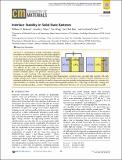| dc.contributor.author | Miara, Lincoln J. | |
| dc.contributor.author | Wang, Yan | |
| dc.contributor.author | Kim, Jae Chul | |
| dc.contributor.author | Ceder, Gerbrand | |
| dc.contributor.author | Richards, William Davidson | |
| dc.date.accessioned | 2016-03-25T18:26:39Z | |
| dc.date.available | 2016-03-25T18:26:39Z | |
| dc.date.issued | 2015-12 | |
| dc.date.submitted | 2015-12 | |
| dc.identifier.issn | 0897-4756 | |
| dc.identifier.issn | 1520-5002 | |
| dc.identifier.uri | http://hdl.handle.net/1721.1/101875 | |
| dc.description.abstract | Development of high conductivity solid-state electrolytes for lithium ion batteries has proceeded rapidly in recent years, but incorporating these new materials into high-performing batteries has proven difficult. Interfacial resistance is now the limiting factor in many systems, but the exact mechanisms of this resistance have not been fully explained - in part because experimental evaluation of the interface can be very difficult. In this work, we develop a computational methodology to examine the thermodynamics of formation of resistive interfacial phases. The predicted interfacial phase formation is well correlated with experimental interfacial observations and battery performance. We calculate that thiophosphate electrolytes have especially high reactivity with high voltage cathodes and a narrow electrochemical stability window. We also find that a number of known electrolytes are not inherently stable but react in situ with the electrode to form passivating but ionically conducting barrier layers. As a reference for experimentalists, we tabulate the stability and expected decomposition products for a wide range of electrolyte, coating, and electrode materials including a number of high-performing combinations that have not yet been attempted experimentally. | en_US |
| dc.description.sponsorship | Samsung Advanced Institute of Technology | en_US |
| dc.language.iso | en_US | |
| dc.publisher | American Chemical Society (ACS) | en_US |
| dc.relation.isversionof | http://dx.doi.org/10.1021/acs.chemmater.5b04082 | en_US |
| dc.rights | Article is made available in accordance with the publisher's policy and may be subject to US copyright law. Please refer to the publisher's site for terms of use. | en_US |
| dc.source | ACS | en_US |
| dc.title | Interface Stability in Solid-State Batteries | en_US |
| dc.type | Article | en_US |
| dc.identifier.citation | Richards, William D., Lincoln J. Miara, Yan Wang, Jae Chul Kim, and Gerbrand Ceder. “Interface Stability in Solid-State Batteries.” Chem. Mater. 28, no. 1 (January 12, 2016): 266–273. © 2015 American Chemical Society | en_US |
| dc.contributor.department | Massachusetts Institute of Technology. Department of Materials Science and Engineering | en_US |
| dc.contributor.mitauthor | Richards, William Davidson | en_US |
| dc.contributor.mitauthor | Wang, Yan | en_US |
| dc.contributor.mitauthor | Kim, Jae Chul | en_US |
| dc.contributor.mitauthor | Ceder, Gerbrand | en_US |
| dc.relation.journal | Chemistry of Materials | en_US |
| dc.eprint.version | Final published version | en_US |
| dc.type.uri | http://purl.org/eprint/type/JournalArticle | en_US |
| eprint.status | http://purl.org/eprint/status/PeerReviewed | en_US |
| dspace.orderedauthors | Richards, William D.; Miara, Lincoln J.; Wang, Yan; Kim, Jae Chul; Ceder, Gerbrand | en_US |
| dc.identifier.orcid | https://orcid.org/0000-0001-9999-6853 | |
| dc.identifier.orcid | https://orcid.org/0000-0002-8126-5048 | |
| dc.identifier.orcid | https://orcid.org/0000-0002-8648-2172 | |
| mit.license | PUBLISHER_POLICY | en_US |
| mit.metadata.status | Complete | |
